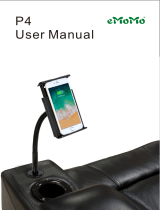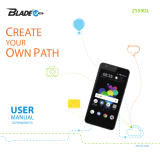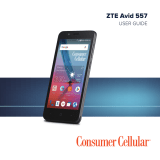Page is loading ...

1
Z610
User Guide

2
LEGAL INFORMATION
Copyright © 2019 ZTE CORPORATION.
All rights reserved.
No part of this publication may be quoted,
reproduced, translated or used in any form or by
any means, electronic or mechanical, including
photocopying and microfilm, without the prior
written permission of ZTE Corporation.
Notice
ZTE Corporation reserves the right to make
modifications on print errors or update
specifications in this guide without prior notice.
We offer self-service for our smart terminal device
users. Please visit the ZTE official website (at
www.ztedevices.com) for more information on
self-service and supported product models.
Information on the website takes precedence.
Disclaimer
ZTE Corporation expressly disclaims any liability
for faults and damages caused by unauthorized
modifications of the software.
Images and screenshots used in this guide may
differ from the actual product. Content in this guide
may differ from the actual product or software.
Trademarks
ZTE and the ZTE logos are trademarks of ZTE
Corporation.
Android™ is a trademark of Google LLC.
The Bluetooth®word mark and logos are registered
trademarks owned by the Bluetooth SIG, Inc. and
any use of such marks by ZTE Corporation is under
license.
microSDXC Logo is a trademark of
SD-3C, LLC.
For DTS patents, see http://patents.dts.com.

3
Manufactured under license from DTS Licensing
Limited. DTS, the Symbol, & DTS and the Symbol
together are registered trademarks or trademarks
of DTS, Inc. in the United States and/or other
countries. © DTS, Inc. All Rights Reserved.
Other trademarks and trade names are those of
their respective owners.
Version No.: R1.0
Edition Time : July 25, 2022

4
Getting to Know Your Phone

5
Installing the nano-SIM Card and
the microSDXC™ Card (Optional)
The nano-SIM card can be installed or removed
while the phone is turned on.
WARNING!
To avoid damage to the phone, do not use any
other kind of SIM cards, or any non-standard
nano-SIM card cut from a SIM/micro-SIM card. You
can get a standard nano-SIM card from your
service provider.
1. Insert the tip of the tray eject tool into the hole
next to the card tray.

6
2. Pull out the card tray and place the nano-SIM
card(s) and the microSDXC card on the tray,
as shown. Carefully slide the tray back into
place.
Charging the Phone
Your phone’s battery should have enough power for
the phone to turn on, find a signal, and make a few
calls. You should fully charge the battery as soon
as possible.
WARNING!
Use only ZTE-approved chargers and USB Type-C
cables. The use of unapproved accessories could
damage your phone or cause the battery to explode.
NOTE:
Use the charger that comes in-box with your phone
to charge the battery.
WARNING!
Do not remove the back cover. The battery is
not removable. Removal may cause fire or
explosion.

7
NOTE:
If the battery is extremely low, you may be unable
to power on the phone even when it is being
charged. In this case, try again after charging the
phone for at least 20 minutes. Contact the
customer service if you still cannot power on the
phone after prolonged charging.
NOTE:
If the screen freezes or takes too long to respond,
try pressing and holding the Power key for about
10 seconds to restart the phone.

8
Product Safety Information
Don’t make or receive phone calls while
driving. Never text while driving.
Keep your phone at least 10 mm away
from your body while making calls.
Small parts may cause choking.
Your phone can produce a loud sound.
To prevent possible hearing damage, do
not listen at high volume levels for long
periods. Exercise caution when holding
your phone near your ear while the
loudspeaker is in use.
Avoid contact with anything magnetic.
Keep away from pacemakers and other
electronic medical devices.
Turn off when asked to in hospitals and
medical facilities.
Turn off when told to on aircraft and at
airports.
Turn off when near explosive materials
or liquids.
Don’t use at gas stations.
Your phone may produce a bright or
flashing light.
Don’t dispose of your phone in fire.
Avoid extreme temperatures.

9
Avoid contact with liquids. Keep your
phone dry.
Do not attempt to disassemble your
phone.
Only use approved accessories.
Don’t rely on your phone as a primary
device for emergency communications.
Radio Frequency (RF) Energy
This phone is designed and manufactured not to
exceed the emission limits for exposure to radio
frequency (RF) energy set by the Federal
Communications Commission of the United States.
During SAR testing, this device was set to transmit
at its highest certified power level in all tested
frequency bands, and placed in positions that
simulate RF exposure in usage against the head
with no separation, and near the body with the
separation of 0.4 inches (10 mm). Although the
SAR is determined at the highest certified power
level, the actual SAR level of the device while
operating can be well below the maximum value.
This is because the phone is designed to operate at
multiple power levels so as to use only the power
required to reach the network. In general, the closer
you are to a wireless base station antenna, the
lower the power output.
The exposure standard for wireless devices
employing a unit of measurement is known as the

10
Specific Absorption Rate, or SAR. The SAR limit
set by the FCC is 1.6 W/kg.
This device is complied with SAR for general
population/uncontrolled exposure limits in
ANSI/IEEE C95.1-1992 and had been tested in
accordance with the measurement methods and
procedures specified in IEEE1528.
The FCC has granted an Equipment Authorization
for this model phone with all reported SAR levels
evaluated as in compliance with the FCC RF
exposure guidelines. SAR information on this
model phone is on file with the FCC and can be
found under the Display Grant section of
www.fcc.gov/oet/ea/fccid after searching on FCC
ID: SRQ-Z6103.
For this device, the highest reported SAR value for
usage against the head is 1.40 W/kg, and for
usage near the body is 1.19 W/kg.
While there may be differences between the SAR
levels of various phones and at various positions,
they all meet the government requirements.
SAR compliance for body-worn operation is based
on a separation distance of 0.4 inches (10 mm)
between the unit and the human body. Carry this
device at least 0.4 inches (10 mm) away from your
body to ensure RF exposure level compliant or
lower to the reported level. To support body-worn
operation, choose the belt clips or holsters, which
do not contain metallic components, to maintain a
separation of 0.4 inches (10 mm) between this

11
device and your body.
RF exposure compliance with any body-worn
accessory that contains metal was not tested and
certified, and use of such body-worn accessory
should be avoided.
FCC Regulations
This device complies with part 15 of the FCC Rules.
Operation is subject to the following two conditions:
(1) This device may not cause harmful interference,
and (2) this device must accept any interference
received, including interference that may cause
undesired operation.
This equipment has been tested and found to
comply with the limits for a Class B digital device,
pursuant to part 15 of the FCC Rules. These limits
are designed to provide reasonable protection
against harmful interference in a residential
installation. This equipment generates, uses and
can radiate radio frequency energy and, if not
installed and used in accordance with the
instructions, may cause harmful interference to
radio communications. However, there is no
guarantee that interference will not occur in a
particular installation. If this equipment does cause
harmful interference to radio or television reception,
which can be determined by turning the equipment
off and on, the user is encouraged to try to correct
the interference by one or more of the following
measures:

12
Reorient or relocate the receiving antenna.
Increase the separation between the equipment
and receiver.
Connect the equipment into an outlet on a
circuit different from that to which the receiver is
connected.
Consult the dealer or an experienced radio/TV
technician for help.
CAUTION:
Changes or modifications not expressly approved
by the manufacturer could void the user’s authority
to operate the equipment.
The antenna(s) used for this transmitter must not
be co-located or operating in conjunction with any
other antenna or transmitter.
Hearing Aid Compatibility (HAC)
Regulations for Mobile Phones
In 2003, the FCC adopted rules to make digital
wireless telephones compatible with hearing aids
and cochlear implants. Although analog wireless
phones do not usually cause interference with
hearing aids or cochlear implants, digital wireless
phones sometimes do because of electromagnetic
energy emitted by the phone's antenna, backlight,
or other components. Your phone is compliant with
FCC HAC regulations (ANSI C63.19- 2011).
While some wireless phones are used near some

13
hearing devices (hearing aids and cochlear
implants), users may detect a buzzing, humming,
or whining noise. Some hearing devices are more
immune than others to this interference noise and
phones also vary in the amount of interference they
generate. The wireless telephone industry has
developed a rating system for wireless phones to
assist hearing device users in finding phones that
may be compatible with their hearing devices. Not
all phones have been rated. Phones that are rated
have the rating on their box or a label located on
the box. These ratings are not guaranteed. Results
will vary, depending on the level of immunity of your
hearing device and the degree of your hearing loss.
If your hearing device happens to be vulnerable to
interference, you may not be able to use a rated
phone successfully. Trying out the phone with your
hearing device is the best way to evaluate it for
your personal needs.
This phone has been tested and rated for use with
hearing aids for some of the wireless technologies
that it uses. However, there may be some newer
wireless technologies used in this phone that have
not been tested yet for use with hearing aids. It is
important to try the different features of this phone
thoroughly and in different locations, using your
hearing aid or cochlear implant, to determine if you
hear any interfering noise. Consult your service
provider or the manufacturer of this phone for
information on hearing aid compatibility. If you have
questions about return or exchange policies,

14
consult your service provider or phone retailer.
M-Ratings: Phones rated M3 or M4 meet FCC
requirements and are likely to generate less
interference to hearing devices than phones that
are not labeled. M4 is the better/higher of the two
ratings.
T-Ratings: Phones rated T3 or T4 meet FCC
requirements and are likely to be more usable with
a hearing device’s telecoil (“T Switch” or
“Telephone Switch”) than unrated phones. T4 is the
better/ higher of the two ratings. (Note that not all
hearing devices contain telecoils.)
Your Z6103 has been tested for hearing aid device
compatibility and has an M4/T3 rating.
Hearing devices may also be measured for
immunity to this type of interference. Your hearing
device manufacturer or hearing health professional
may help you find results for your hearing device.
For additional information about the FCC’s actions
with regard to hearing aid compatible wireless
devices and other steps the FCC has taken to
ensure that individuals with disabilities have access
to telecommunications services, please go to
www.fcc.gov/cgb/dro.
CTIA Requirements
Do not disassemble or open, crush, bend or
deform, puncture or shred the battery.
Do not modify or remanufacture, attempt to

15
insert foreign objects into the battery, immerse
or expose to water or other liquids, expose to
fire, explosion or other hazards.
Only use the battery for the device for which it
is specified.
Only use the battery with a charging system
that has been qualified with the system per
CTIA Certification Requirements for Battery
System Compliance to IEEE 1725. Use of an
unqualified battery or charger may present a
risk of fire, explosion, leakage, or other
hazards.
Do not short-circuit the phone or allow metallic
conductive objects to contact the charging
terminals.
Replace the battery only with another battery
that has been qualified with the system per this
standard, IEEE-Std-1725. Use of an
unqualified battery may present a risk of fire,
explosion, leakage or other hazards. Only
authorized service providers shall replace the
battery. (If the battery is non-user replaceable).
Promptly dispose of used batteries in
accordance with local regulations.
Battery usage by children should be
supervised.
Avoid dropping the phone or battery. If the
phone or battery is dropped, especially on a
hard surface, and the user suspects damage,
take it to a service center for inspection.

16
Improper battery use may result in a fire,
explosion or other hazards.
The phone shall only be connected to CTIA
certified adapters, products that bear the
USB-IF logo or products that have completed
the USB-IF compliance program.
Distractions
Driving
Full attention must be given to driving at all times in
order to reduce the risk of an accident. Using a
phone while driving (even with a hands-free kit) can
cause distraction and lead to an accident. You must
comply with local laws and regulations restricting
the use of wireless devices while driving.
Operating Machinery
Full attention must be given to operating the
machinery in order to reduce the risk of an
accident.
Product Handling
General Statement on Handling and Use
You alone are responsible for how you use your
phone and any consequences of its use.
You must always switch off your phone wherever
the use of a phone is prohibited. Use of your phone
is subject to safety measures designed to protect

17
users and their environment.
Always treat your phone and its accessories
with care and keep them in a clean place.
Keep the screen and camera lens clean. An
unclean screen or camera lens may slow down
the phone's reaction to your operations or
interfere with the image quality.
Clean your phone and its accessories with a
soft material such as cleaning cloth for
eyeglass lenses. Do not use alcohol or other
corrosive substances for cleaning or allow
them to get inside.
Do not expose your phone or its accessories to
open flames or lit tobacco products.
Do not expose your phone or its accessories to
liquid, moisture or high humidity.
Do not drop, throw or try to bend your phone or
its accessories.
Do not use harsh chemicals, cleaning solvents,
or aerosols to clean the device or its
accessories.
Do not paint your phone or its accessories.
Do not attempt to disassemble your phone or
its accessories. Only authorized personnel can
do so.
Do not place your phone inside or near heating
equipment or high-pressure containers, such
as water heaters, microwave ovens, or hot
cooking utensils. Otherwise, your phone may

18
be damaged.
Please check local regulations for disposal of
electronic products.
Do not carry your phone in your back pocket
as it could break when you sit down.
Battery Safety
Using ZTE-unapproved or incompatible battery,
charger or power adapter may damage your
device, shorten its lifespan or cause a fire,
explosion or other hazards.
The recommended operating temperatures are
0 °C to 35 °C and the storage temperatures
are -20 °C to +45 °C. Extreme temperatures
can damage the device and reduce the
charging capacity and lifespan of your device
and battery.
Do not remove the back cover. The battery is
not removable. Removal may cause fire or
explosion.
Do not change or replace the built-in
rechargeable battery in your device by yourself.
The battery can only be changed or replaced
by ZTE or ZTE-authorized service provider.
Do not place the device or the battery in or
near heating equipment, such as microwave
ovens, stoves or radiators. Keep the device
and the battery away from excessive heat and
direct sunlight. If not, the device or the battery
may overheat and cause explosion or fire.

19
Do not disassemble, squeeze or puncture the
device, as this can cause explosion or fire.
Do not throw the device into a fire to avoid
explosion.
Please disconnect the charger when the
battery is fully charged. Overcharging may
shorten the battery life.
When not using the device for a long period,
please charge the battery about half and then
store the device in a cool dry place.
If the battery damages or shows signs of
swelling or leakage, please stop use
immediately and contact ZTE or an
ZTE-authorized service provider for
replacement.
Small Children
Do not leave your phone and its accessories within
the reach of small children or allow them to play
with it. They could hurt themselves or others, or
could accidentally damage the phone. Your phone
contains small parts with sharp edges that may
cause an injury or may become detached and
create a choking hazard.
Demagnetization
To avoid the risk of demagnetization, do not allow
electronic devices or magnetic media close to your
phone for a long time.

20
Electrostatic Discharge (ESD)
Do not touch the metal connectors on the nano-SIM
card and the microSDXC card.
Antenna
Do not touch the antenna unnecessarily.
Normal Use Position
When placing or receiving a phone call, hold your
phone to your ear, with the bottom towards your
mouth.
Airbags
Do not place a phone in the area over an airbag or
in the airbag deployment area, as an airbag inflates
with great force and serious injury could result.
Store the phone in a safe and secure area before
driving your vehicle.
Seizures/Blackouts
The phone can produce a bright or flashing light. A
small percentage of people may be susceptible to
blackouts or seizures (even if they have never had
one before) when exposed to flashing lights or light
patterns such as when playing games or watching
video. If you have experienced seizures or
blackouts or have a family history of such
occurrences, please consult a physician. To reduce
the risk of blackouts or seizures, use your phone in
a well-lit room and take frequent breaks.
/





